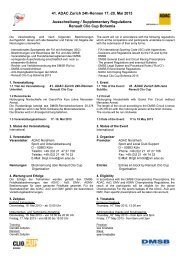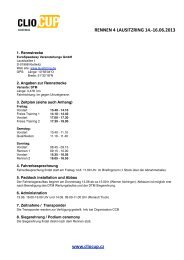Pro praxi - Clio Cup
Pro praxi - Clio Cup
Pro praxi - Clio Cup
You also want an ePaper? Increase the reach of your titles
YUMPU automatically turns print PDFs into web optimized ePapers that Google loves.
V Coventry proto pro rok 1953 zkoušeli několik technických inovací<br />
včetně kotoučových brzd. Ty byly opět testovány při závodě Mille<br />
Miglia na voze Tonyho Rolta a poté byly použity na všech továrních<br />
vozech nasazených v Le Mans. Díky tomu mohly na dlouhé rovince<br />
Les Hunaudiéres jet Jaguary C-Type déle maximální rychlostí a tím<br />
eliminovat vyšší maximální rychlost vozů Ferrari a Lancia. Výsled-<br />
kem byl naprostý triumf v té době už tři roky starých Jaguarů C-Type<br />
- vyhrál vůz řízený Tonym Roltem a Duncanem Hamiltonem a další<br />
dojely druhý a čtvrtý. Jaguar u kotoučových brzd zůstal i u nového<br />
D-Type.<br />
Ve F1 se kotoučové brzdy prosazovaly s obtížemi. Stirlinga Mosse<br />
lepší schopnosti kotoučových brzd natolik zaujaly, že si je nechal<br />
namontovat i do monopostu Cooper-Alta, s nímž startoval ve Velké<br />
ceně Itálie v Monze v roce 1953. Jenže toto auto bylo hodně špatné,<br />
takže byla tato novinka přehlédnuta. Už od roku 1952 ale kotoučové<br />
brzdy Goodyear zkoušel Tony Vandervell v monopostech Thinwall<br />
Special, což byly upravené Ferrari. Získané zkušenosti uplatnil<br />
v roce 1954, kdy se jeho nový vůz Vanwall stal úplně prvním monopostem<br />
F1 od počátku konstruovaným pro použití kotoučových<br />
brzd. Na první vítězství v mistrovství světa si kotoučové brzdy<br />
musely počkat až do roku 1957, kdy Stirling Moss a Tony Brooks<br />
vyhráli s vozem Vanwall Velkou cenu Velké Británie. A přesně o rok<br />
později opět ve Velké Británii dosáhl Peter Collins s Ferrari posledního<br />
vítězství s vozem vybaveným bubnovými brzdami.<br />
Vladimír Rybecký<br />
Foto Jaguar<br />
History<br />
During preparation for 1953 in Coventry they therefore tried several<br />
technical innovations including disc brakes. These brakes were tested<br />
once again during the Mille Miglia race in the car driven by Tony Rolt and<br />
then they were used in all works racing cars competing in Le Mans. Thanks<br />
to this fact C-Type Jaguars could ran longer at a maximum speed on the<br />
long Les Hunaudiéres straight and eliminate a higher top speed of Ferraris<br />
and Lancias. It resulted in the absolute triumph of the three years<br />
old design C-Type Jaguar. The race was won by the car driven by Tony<br />
Rolt and Duncean Hamilton. Other C-Types finished second and fourth.<br />
Jaguar kept disc brakes also at the new D-Type.<br />
In Formula One disc brake broke through with difficulties. Stirling Moss<br />
was so impressed by better capabilities of disc brakes that he fitted them<br />
in the single-seater Cooper-Alta for the 1953 Italian Grand Prix at Monza.<br />
However, this car was so bad that the novelty failed to be noticed. Nevertheless<br />
Goodyear disc brakes were tested already since 1952 by Tony<br />
Vandervell`s team in Thinwall Special single-seaters which were in fact<br />
adapted Ferrari cars. Obtained experience he applied in 1954. His new<br />
Vanwall became the very first Formula One car designed from the beginning<br />
for disc brakes use. Disc brakes had to wait for their first win in the<br />
World Championship till 1957 when Stirling Moss and Tony Brooks won<br />
the Great Britain Grand Prix with Vanwall. And exactly one year later<br />
Peter Collins achieved again in Great Britain the last win with a car equipped<br />
with drum brakes. Vladimír Rybecký, Photo: Jaguar<br />
Jaguar C-Type přinesl několik technických inovací, ale do historie se<br />
zapsal především úspěšným použitím kotoučových brzd.<br />
The C-Type Jaguar brought several technical innovations but it entered the<br />
history by the first successful use of disc brakes.<br />
Motorsport-Ing. 2/2012 63






